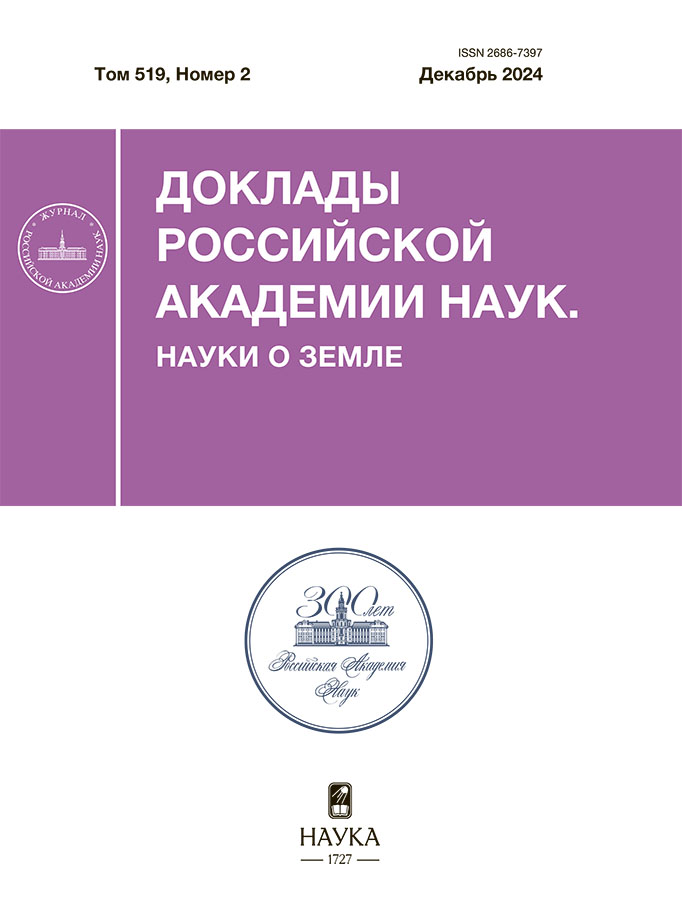Small mammals from the Taurida locality (Crimea, Pleistocene): systematic composition and biochronology
- Authors: Lopatin A.V.1, Tesakov A.S.2
-
Affiliations:
- Borissiak Paleontological Institute, Russian Academy of Sciences
- Geological Institute, Russian Academy of Sciences
- Issue: Vol 519, No 2 (2024)
- Pages: 83-90
- Section: PALEONTOLOGY
- Submitted: 04.06.2025
- Published: 28.12.2024
- URL: https://edgccjournal.org/2686-7397/article/view/682453
- DOI: https://doi.org/10.31857/S2686739724120117
- ID: 682453
Cite item
Abstract
The dominance of the voles Lagurodon arankae (Kretzoi, 1954) and Allophaiomys deucalion Kretzoi, 1969 in the Early Pleistocene small mammalian fauna from the main bone-bearing level of the Taurida cave (central Crimea) allows dating this faunal association to the beginning of the Calabrian (about 1.8–1.6 Ma), and correlating it to the Late Villafranchian and the MQ1 zone of the European mammal biochronological scale, the second half of the Psekupsian Faunal Assemblage, and the regional mammal zone MQR10 (Allophaiomys deucalion – Prolagurus ternopolitanus zone). The lower part of the cave deposits was found to contain components of the more ancient regional mammal zone MQR11 (Allophaiomys deucalion – Borsodia zone), which dates to the terminal Gelasian. Thus, the Early Pleistocene phase of the formation of the Taurida locality corresponds to the time interval of about 2.1–1.6 Ma. The cave deposits also yield remains of Middle Pleistocene small mammals dominated by the vole Microtus ex gr. arvalis (Pallas, 1778). The evolutionary level of these associations suggests an age of the mid Middle Pleistocene (about 0.5–0.3 Ma) and correlation with the regional mammal zone MQR3 (Arvicola mosbachensis – Lagurus transiens zone).
Keywords
Full Text
About the authors
A. V. Lopatin
Borissiak Paleontological Institute, Russian Academy of Sciences
Author for correspondence.
Email: alopat@paleo.ru
Academician of the RAS
Russian Federation, MoscowA. S. Tesakov
Geological Institute, Russian Academy of Sciences
Email: tesak@ginras.ru
Russian Federation, Moscow
References
- Лопатин А.В., Вислобокова И.А., Лавров А.В. и др. Пещера Таврида – новое местонахождение раннеплейстоценовых позвоночных в Крыму // ДАН. 2019. Т. 485. № 3. С. 381–385.
- Вислобокова И.А., Титов В.В., Лавров А.В. и др. О находке большерогого оленя рода Arvernoceros в пещере Таврида в Крыму // ДАН. 2019. Т. 487. № 5. С. 596–599.
- Вислобокова И.А., Титов В.В., Лавров А.В. и др. Раннеплейстоценовые винторогие антилопы (Artiodactyla, Bovidae) из пещеры Таврида (Крым, Россия) // Палеонтологический журнал. 2020. № 1. С. 78–88.
- Gimranov D., Lavrov A., Prat-Vericat M. et al. Ursus etruscus from the late Early Pleistocene of the Taurida cave (Crimean Peninsula) // Historical Biology. 2023. V. 35. № 6. P. 843–856.
- Zelenkov N.V., Lavrov A.V., Startsev D.B. et al. A giant early Pleistocene bird from eastern Europe: unexpected component of terrestrial faunas at the time of early Homo arrival // Journal of Vertebrate Paleontology. 2019. V. 39. № 2. Art. e1605521. https://doi.org/10.1080/02724634.2019.1605521
- Зеленков Н. В. Ископаемый каменный огарь (Tadorna petrina) и широконоска (Spatula praeclypeata sp. nov.) – древнейшие раннеплейстоценовые утиные (Aves: Anatidae) Крыма // Палеонтологический журнал. 2022. № 6. С. 92–104.
- Зеленков Н. В. Новый вид рябков (Aves: Pterоclidae) из раннего плейстоцена Крыма // Доклады РАН. Науки о жизни. 2023. Т. 511. С. 371–374.
- Лопатин А. В. Совместное присутствие Hypolagus и Lepus (Leporidae, Lagomorpha) в раннем плейстоцене Крыма // ДАН. 2019. Т. 489. № 6. С. 651–653.
- Лопатин А. В. Крупный дикобраз Hystrix refossa (Rodentia, Hystricidae) из раннеплейстоценового местонахождения Таврида в Крыму // Доклады РАН. Науки о жизни. 2021. Т. 500. № 1. С. 391–401.
- Лопатин А. В. Plecotus macrobullaris sarmaticus subsp. nov. (Vespertilionidae, Chiroptera) из раннего плейстоцена Крыма // Доклады РАН. Науки о жизни. 2024. Т. 516. С. 26–33.
- Лопатин А. В., Тесаков А. С. Раннеплейстоценовая белозубка Crocidura kornfeldi (Lipotyphla, Soricidae) из Крыма // Доклады РАН. Науки о жизни. 2021. Т. 501. № 1. С. 499–504.
- Оксиненко П. В., Лавров А. В. История формирования пещеры Таврида – памятника фауны позвоночных позднего вилафранка и ее палеонтологическое значение // Вестник Московского университета. Серия 5. География. 2021. № 1. С. 27–42.
- Rabeder G. Die Arvicoliden (Rodentia, Mammalia) aus dem Pliozän und dem älterem Pleistozän von Niederösterreich // Beiträge zur Paläontologie von Österreich. 1981. V. 8. P. 1–343.
- Тесаков А. С. Биостратиграфия среднего плиоцена – эоплейстоцена Восточной Европы (по мелким млекопитающим). М.: Наука, 2004.
- Geologic Time Scale 2020 / Eds F. M. Gradstein, J. G. Ogg, M. D. Schmitz, G. M. Ogg. V. 2. Amsterdam: Elsevier, 2020.
- Pastre J. F., Debard E., Nomade S. et al. Nouvelles données géologiques et téphrochronologiques sur le gisement paléontologique du maar de Senèze (Pléistocène inférieur, Massif Central, France) // Quaternaire. 2015. V. 26. P. 225–244.
- Martin R. A., Peláez-Campomanes P., Honey J. G. et al. Rodent community change at the Pliocene–Pleistocene transition in southwestern Kansas and identification of the Microtus immigration event on the Central Great Plains // Palaeogeography, Palaeoclimatology, Palaeoecology. 2008. V. 267. P. 196–207.
- Рековец Л. И. Мелкие млекопитающие антропогена юга Восточной Европы. Киев: Наукова думка, 1994.
- Тесаков А. С., Гайдаленок О. В., Соколов С. А. и др. Тектоника плейстоценовых отложений северо-восточной части Таманского полуострова, Южное Приазовье // Геотектоника. 2019. № 5. С. 12–35.
Supplementary files














